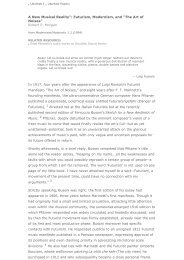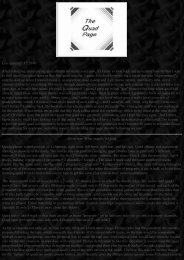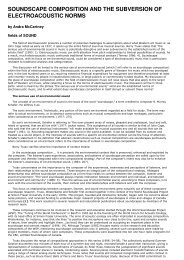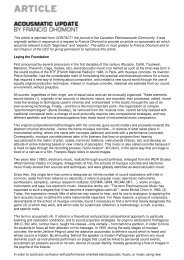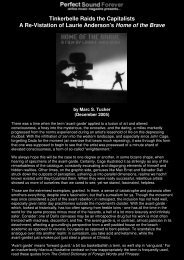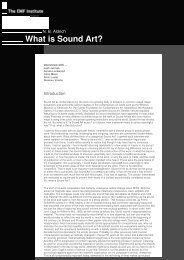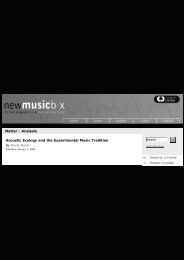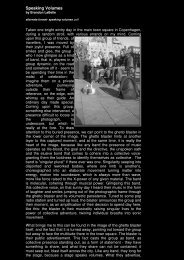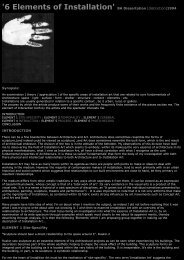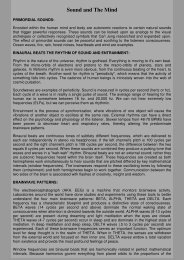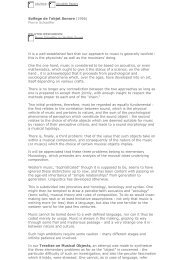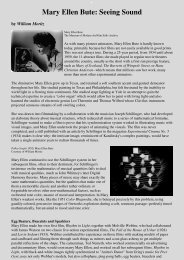Electroacoustic music studies and the danger of loss - Cambridge ...
Electroacoustic music studies and the danger of loss - Cambridge ...
Electroacoustic music studies and the danger of loss - Cambridge ...
You also want an ePaper? Increase the reach of your titles
YUMPU automatically turns print PDFs into web optimized ePapers that Google loves.
52 Marc BattierTable 2General presentationAudio connections set-upMIDI connections set-upAudio <strong>and</strong> MIDI set-up from <strong>the</strong>first per-formanceDigital processing mapDiffusion set-upList <strong>of</strong> all prepared soundfiles<strong>and</strong> sound samplesS<strong>of</strong>tware environmentSignal processing schemePreparation, tests <strong>and</strong> rehearsalPerformanceProgramme notesThis is where <strong>the</strong> reader should become acquainted with <strong>the</strong> specifics <strong>and</strong> <strong>the</strong> intention<strong>of</strong> a piece, as well as its mode <strong>of</strong> presentation <strong>and</strong> performance. A morecomprehensive study could also be included.Place <strong>of</strong> all necessary microphones; audio signal paths to process-ing devices(reverberation, equalisation, compression, spatialisa-tion, o<strong>the</strong>r processing); A/D <strong>and</strong>D/A conversion; routing <strong>of</strong> output <strong>of</strong> audio signals; mixing; connection toloudspeakers.Must display channel numbers. Should show list <strong>of</strong> MIDI devices, control channels<strong>and</strong> patching.Referring to <strong>the</strong> first performance’s set-up is invaluable. While tech-nology will evolve<strong>and</strong> be replaced in <strong>the</strong> future, a snapshot <strong>of</strong> <strong>the</strong> first performance can explain a lot.When digital processing is used (such as with a computer pro-gramme – MAX/MSP,Super Collider, jMax, etc.), a map <strong>of</strong> <strong>the</strong> data flow, a list <strong>of</strong> processing functions <strong>and</strong>I/O modules as well as a careful notation <strong>of</strong> settings is most useful for study (as well asfor a technical port to latter day technology).Live pieces tend to use more than two channels. A map <strong>of</strong> <strong>the</strong> diffu-sion set-up forspatialisation should clarify <strong>the</strong> choices made by <strong>the</strong> composer <strong>and</strong> those taken by <strong>the</strong>technician for a particular per-formance.Direct-to-disk <strong>and</strong> sampler technology tend to evolve rapidly. It is most important toknow <strong>the</strong> sampler’s map, its program settings <strong>and</strong> <strong>the</strong> triggering systems. Screen shotscan be useful.When triggered from a MIDI device (keyboard or gestural control-ler),precise MIDI messages (usually voice messages) should be noted. It may be that <strong>the</strong>performer’s score has <strong>the</strong>se indications already.In addition to <strong>the</strong> information given in table 1, this is where a com-prehensiveindication <strong>of</strong> <strong>the</strong> overall s<strong>of</strong>tware environment is given (list <strong>of</strong> necessary plug-ins,abstractions, patches, programs, settings).Data flow representation <strong>of</strong> <strong>the</strong> signal processing algorithms.Steps to be followed to install <strong>the</strong> set-up <strong>and</strong> conduct tests. Indica-tion <strong>of</strong> rehearsalprocedure.Steps to be followed <strong>and</strong> overall procedure for <strong>the</strong> performance <strong>of</strong> <strong>the</strong> piece.The programme note is a paratext. As such, it is important to use <strong>the</strong> programmenotes from <strong>the</strong> first performance, although o<strong>the</strong>r versions might have been producedlater.documentation on living composers <strong>and</strong> <strong>music</strong> from<strong>music</strong>ians working in <strong>the</strong>ir own country, such asscores, paratexts, associated documents <strong>and</strong> audiorecordings. Finally, museums not only acquire, store<strong>and</strong> preserve <strong>music</strong>al instruments, but <strong>of</strong>ten giveresearchers access to <strong>the</strong>ir own document recordsarchives.When it comes to classifying methods, one encountersseveral approaches. Museums, for instance,have <strong>the</strong>ir own agenda <strong>of</strong> preserving, restoring <strong>and</strong>sometimes finding ways to keep instruments in aplayable state, <strong>and</strong> accompanying repository documentsare used as technical guidelines for <strong>the</strong>se aims. 5Major libraries, on <strong>the</strong> o<strong>the</strong>r h<strong>and</strong>, especially nationalones, are more focused on archival methods.5On <strong>the</strong> steps taken by a museum regarding electronic <strong>music</strong>alinstruments, see Sylvie Ramel’s article in this issue.One cannot expect electroacoustic <strong>music</strong> centres toconduct thorough data management. Most <strong>of</strong> <strong>the</strong>msimply do not have <strong>the</strong> time, <strong>the</strong> resources, <strong>the</strong> methodology.Their interest lies elsewhere, mostly in <strong>the</strong> production<strong>of</strong> new <strong>music</strong> <strong>and</strong> in its public performance.It is a complex task to ga<strong>the</strong>r <strong>the</strong> documentationnecessary to electroacoustic <strong>music</strong> <strong>studies</strong>.An important missing tool is a <strong>the</strong>saurus. A multilingual<strong>the</strong>saurus would be a useful instrument forunderst<strong>and</strong>ing terms whose meanings are sometimesuncertain or have changed over time. For instance,<strong>the</strong> word ‘sample’ has taken a whole new significance<strong>the</strong>se days. At <strong>the</strong> onset <strong>of</strong> computer <strong>music</strong>, <strong>the</strong> term‘sample’ is what digitalisation <strong>and</strong> sampling <strong>the</strong>orydefines as a single number representing an instantaneousamplitude in a waveform. With <strong>the</strong> arrival <strong>of</strong>real-time recording devices in 1980, <strong>the</strong> word was used



